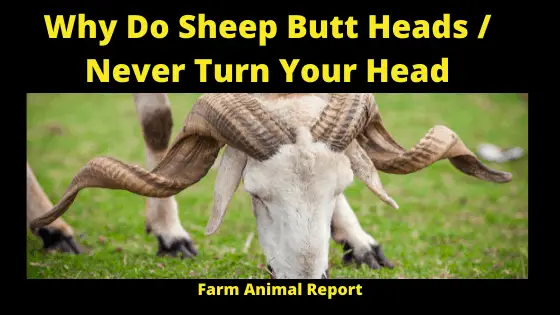As a General Rule Headbutting is aggressive dominant behavior in sheep. This could be with other sheep or with people. Headbutting usually happens when a pair of rams both think they should be the ones in charge of the pasture, so a challenge starts. Aggressive Behavior also includes 1) Pawing the Ground 2)Nibbling 3) Charging 4) Vocal Threats
Why Do Rams Butt Heads?
Sheep Butting Heads / Romance / Predators
Why Do Rams Headbutt? – Sheep have sometimes butted their heads for a variety of reasons. The most dramatic would be the head-butting of rival or dominant males who will charge from several yards away for an impact that would kill any other animal. Why Do Rams Butt Heads?
Youngsters will butt heads in play. This seldom requires a “running charge”, the “players” generally dance around a bit, before rearing up and butting each other, or will butt from a standing position. Even females will butt heads for domination within the herd.
Butting is also used as a defense against predators or to protect the young. The flight is usually the first response in these situations, but if this isn’t possible, butting may be the next response.
Check Our Amazons Resources on Sheep
It wouldn’t work in cases in which the predator was able to get within biting or (in the case of a bear) grabbing distance but if the goat/sheep had the space to get a bit of a run, a good hard butt could break ribs or do serious injury.
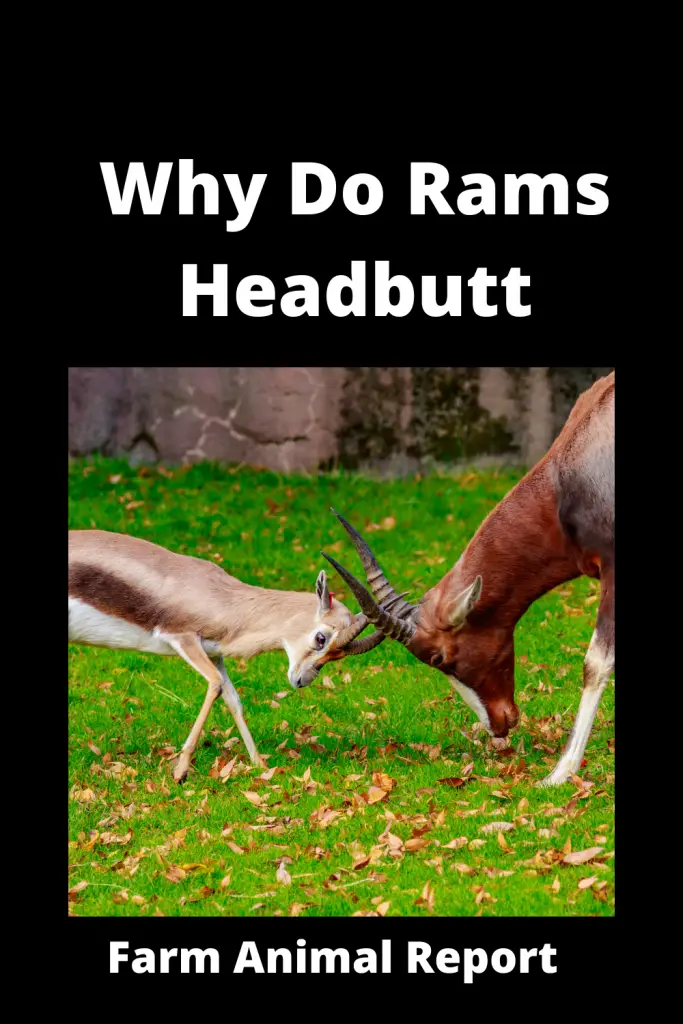
Butting Animals / Shock Absorber Horns
Butting / Natural and Learned Behavior
Butting Because Rutting / Mating
Classic head butting among rams is highest during the rutting season which proceeds the onset of estrus activity in ewes. It is a way for rams to get into physical shape for the breeding season and to establish (or re-establish) the dominance hierarchy. Why do Rams Headbutt
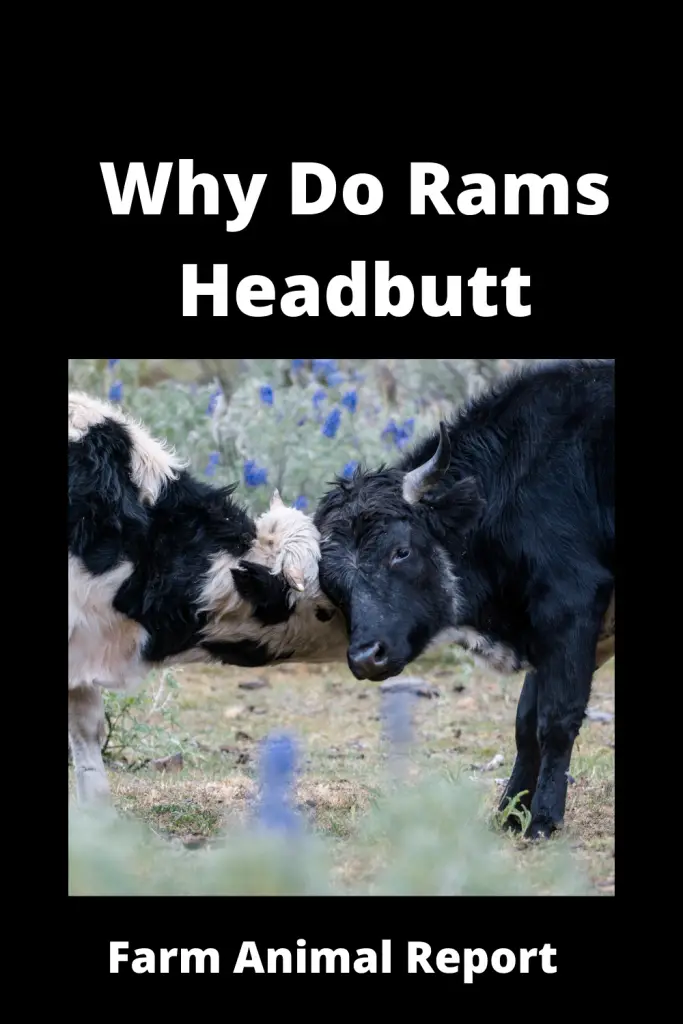
See Our Extensive Guide – 16 Ways to Make Money Sheep Farming
Establishing a Social Order
Sheep are the classical flocking animal. They work out a social order by head butting, poking with horns, shoulder pushing, blocking, and mounting. This is seen most clearly in rams who back off, then charge, meeting head-to-head with a large bang.
Rams begin to butt at a young age.
To discourage butting, you should avoid petting or scratching a ram on the head.
The ram may see this as a challenge or aggressive behavior. To a ram, a person is part of the flock and he wants to dominate. It can be difficult to stop an aggressive ram from butting.
Striking him may make him more aggressive or cause him injury.
Discouraging Butting
- Spraying Water
- Mask – Stops Rams Vision
- Cull The Too Aggressive
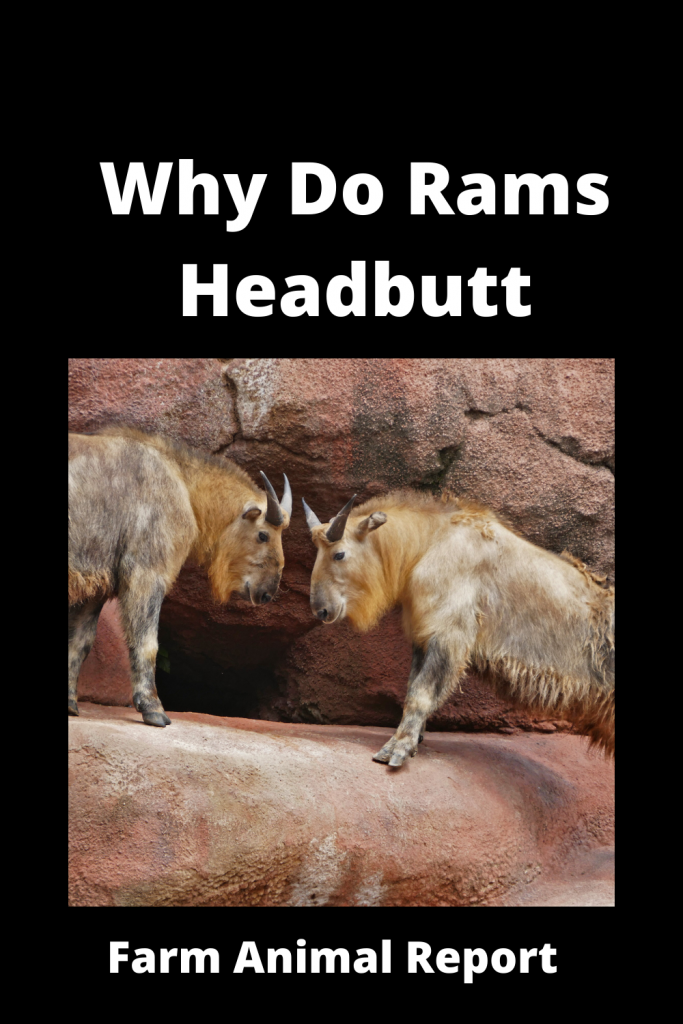
Spraying water on the ram’s face may dissuade him from butting. You can put a mask on the ram to keep him from butting. The mask blocks his side vision. Sometimes, the best course of action is to cull a ram that is overly aggressive.
Never Turn Your Back on a Ram
No matter how friendly a ram may seem; he should never be trusted. You should never turn your back on a ram. Ram can cause serious injury to you and other sheep.
Ram Behavior
Rams have many typical behaviors that most producers are familiar with and expect to observe on a regular basis. Of these behaviors, sexual behavior is the most important to the breeding program and the future of the flock.
Aggressive Behaviors Toward Humans
- Pawing the Ground
- Nibbling
- Head Butting
- Charging
- Vocal
Aggressive behaviors are associated with normal sexual behavior and highest during the breeding season. Sexual behaviors that can translate to aggressive behaviors towards humans include pawing at the ground, nibbling, head butting, charging, and gargling vocalizations. Normal sexual behaviors are variable between rams.
Some rams are more aggressive than others whereas some are more docile. The extent of sexual behaviors is determined by genetics but also by how the ram was raised. Regardless of an individual ram’s behavior, it is important to remember that all rams are aggressive or have the potential to be aggressive, even if they appear “friendly”.
Ram / Ewe Sexual Behavior
In a pen environment, it has been shown that no relationship exists between dominance and mating behavior. In open environments, there are conflicting results and although the dominant ram can prevent others from mating, it did not necessarily have the highest scores for a percentage of ewes mated number of mounts per estrous ewe or a total number of mounts.
Also, the competition of ewes for a ram may have an effect, although there is no evidence.
Exposure to recently mated rams increases the sexual performance of other rams. Odor cues associated with the ewe or mating per se is thought to enhance the sexual efficiency of unmated rams.
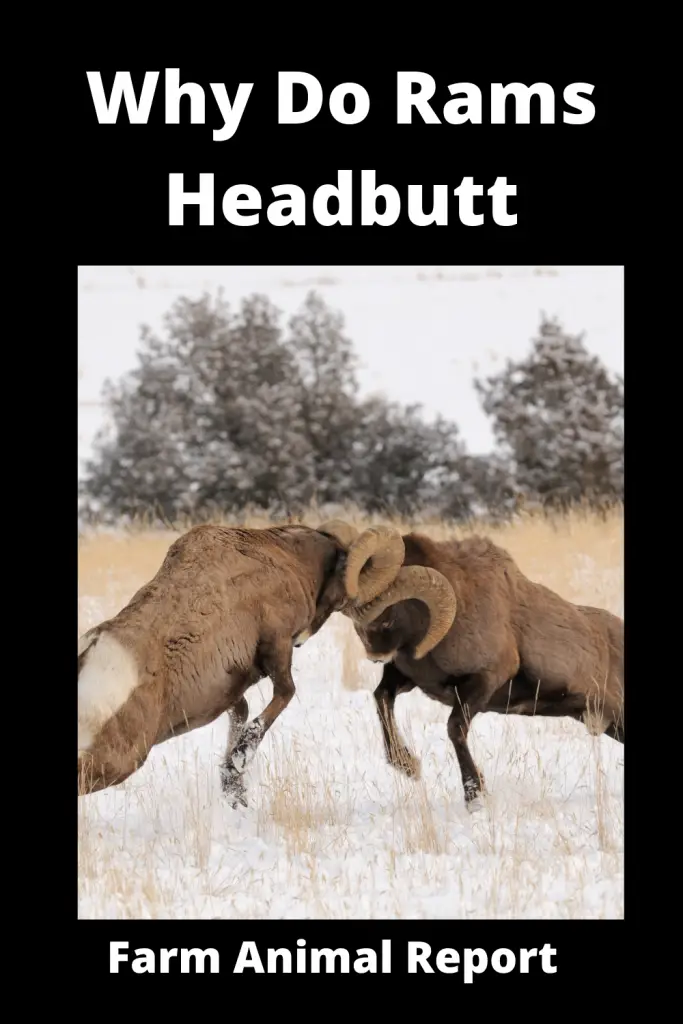
Ram Behavior
The odor of the estrous ewe stimulates the ram, although it is the ewe who seeks out the ram and stays close beside it. The male responds to the urination of the estrous female by sniffing, extending the neck, and curling the lip. This is the flehmen’s response.
The tongue goes in and out and the male may bite the female’s wool, and raise and lower one front leg in a stiff-legged striking motion. If the female is receptive, she will stand for copulation.
In sheep, the duration of sexual receptivity in the presence of the ram is reduced when the ram is continuously present with the ewes.
The continuous presence of ram after the removal of progesterone sponges hastens estrus onset and reduces the interval between sponge removal and ovulation, without modifying estrus duration and time between estrus onset and ovulation in ewes synchronized during the breeding season.
Ewes in estrus will often display ram-seeking behavior, defined as a ewe being persistent in staying at the common fence with attention focused on the ram to the virtual exclusion of grazing.
Mating efficiency may drop if food is short and ewes disperse into small sub-groups. In this situation, the rams may not be able to find them at the usual ratio of 4 rams per 100 ewes. This is one reason that understanding flock behavior under various environmental conditions is so important.
There are several advantages to using withers, which include low cost and convenience of treatment compared to the cost of vasectomy of the ram, and the use of withers to identify ewes for artificial insemination or in the post-mating period to detect non-pregnant ewes.
The use of withers (castrated male sheep) treated with estrogen or testosterone has been shown to be as good as vasectomized rams for inducing ewes to ovulate and for detection of ewes in estrus.
Maternal-offspring Behavior
Some ewes remain with the flock during lambing and others seek isolation. Within seconds of birth, the ewe faces the lamb and begins vigorous licking and eating of fetal membranes. The young must find the teat within 1–2 hours of birth, and it seems that visual cues are very important for successful teat location. Strange lambs are accepted immediately after birth and some ewes adopt newborn lambs if they have lost one.
Ewes Adopting Lambs
Adoptions in sheep flocks are more common than is generally realized and have some consequences in genetic experiments where lambs are identified with their mothers many hours or even days after birth. From about 12 hours after birth, a strange lamb is actively rejected.
Add-on fostering is limited only by the inability to properly match odor-familiar cues on a ewe’s own and alien lambs. Lambs recognize their mothers’ voices by individual differences and ewes recognize their lambs by a variety of cues.
These cues may be vocal recognition. Other workers suggested that recognition depended mainly on smell, while other studies showed that ewes could recognize their lambs from auditory and visual cues alone, but that the correct olfactory cues are required for suckling to be permitted. These cues may be of differing importance depending on the breed of sheep, the size of groups, and the environment they are running in.
Litter size has a strong effect on the time spent grooming the ewe. The birth of the second-born twin results in a dramatic reduction in the grooming of the first-born twin.
Analysis of lamb behavior found that singles were more active, lying for less time and having a greater number of suckling attempts than twins. Offspring behavior has no effect on the onset of bonding behaviors of the ewe, and neonatal lamb activity is largely independent of the behavior of the dam.
Suckling behavior is modified by ewe behavior and this affects the strength of the bond between ewe and lamb. The sheep is a follower species and on the first day of life the ewe remains within one meter of the lamb, so the placement of water, food, and shelter is important.
The distance between ewe and lamb when both are grazing increases rapidly over the next 10 days of life, reaching a plateau with an average distance of 20 meters. Accidental separation in the first few days causes great agitation in both lamb and ewe, and reunion is immediately followed by suckling.
In the first 24 hours after birth, lambs identify their mothers at close quarters only (less than 50 cm), and discrimination at a distance of several meters becomes established only when the lambs are between 2 and 3 days old.
This helps to account for the prevalence of cross-suckling and mis- mothering in the early days of life. Suckling has strong rewarding properties in the establishment of a preferential relationship with the mother by the lamb but the maintenance of this preference does not rely strongly on suckling.
The strength of the ewe-lamb bond is determined mainly by milk yield with a threshold level below which weaning occurs.
Lambs become familiar with and recognize individuals (twins and non-twins) as a result of direct association. They also discriminate between novel scents and artificial odorants associated with their familiar age-mates, but such odors neither mask nor substitute effectively for lambs’ individually recognizable phenotypes.
The management of the maternal-offspring bond is important in the husbandry of lambing ewes. The main objectives are:
- To produce lambs capable of finding teats and suck-ling successfully;
- To produce ewes whose behavior facilitates suck-ling.
Some circumstances delay suckling which will reduce the chances of successful suckling. These include:
- the mother remains to long lying after birth;
- mother circles;
- mother is absent—she may be attending to one twin at the expense of the other; and
- the weather may be too hot or too cold.
The sheep producer can help to ensure that suck-ling is successful in several ways:
- environmental control such as positioning of shade, shelter, food, and water;
- supervision of lambing; and
- selection of suitable breeds who make good mothers.
Abnormal Behavior that Hinders Successful Suckling
The most important abnormal behavior is concerned with maternal behavior. Sometimes the ewe may wander away from her lamb, butt the lamb, or move away as the lamb approaches to suckle.
These behaviors are more common in ewes with twins, who seem unable to recognize that they have more than one lamb. Aggressive behaviors are preferentially directed towards members of the same flock. A small percentage of rams commonly will not mate with estrous females and, if given a choice, will display courtship behavior towards another ram in preference to a female.
This partner-preference behavior of rams may be traceable to fetal development and could represent a phenomenon of sexual differentiation
Why do Rams Headbutt – Why Do Rams Headbutt Each Other
Sheep Associations 10 Breeds of Sheep
| Breeds of Sheep | Country Origin | Purpose of Breed | Use | Ewe Weight | Association For Info |
|---|---|---|---|---|---|
| Suffolk Sheep | Britian / Suffolk | Fast Growing | Meat | 250 - 350 Lbs | United Suffolk Sheep Association |
| Merino Sheep | Spain | Softest Wool | Wool | 100 - 200 Lbs | American and Delane Merino Sheep Association |
| Hampshire | Britain | Best Tasting Mutton | Wool / Meat | 200 Lbs | American Hampshire Sheep Association |
| Romney | England / Romney Marsh | Disease Resistance | Wool / Meat | 225 - 275 Lbs | American Romney Breeders Association |
| Lincoln Sheep | England | Produce Longest Fleece In World | Wool | 250 - 350 Lbs | National Lincoln Sheep Breeders Association |
| Dorper Sheep | South African | Fast Growing Meat | Meat | 230 Lbs | American Droper Sheep association |
| Turcana Sheep | Romainia | Adapted Alpine Pasture | Wool / Milk / Meat | 175 - 200 Lbs | ? |
| Rambouilette Sheep | France | Strong / Hearty / All Climates | Wool / Meat | 300 Lbs | American Rambouilette Sheep Breeders Association |
| Leicester Longwool | United Kingdom | Fast growing / Good Fleece | Wool | 200 Lbs | Leicester Longwool Sheep Breeders Association |


